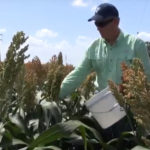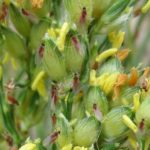Sorghum fields range in maturity from 4-5 leaf to bloom. This is the result of planting across 5-6 weeks. As a result of this we need to be on the lookout for a wide variety of insect pests.
This is the result of planting across 5-6 weeks. As a result of this we need to be on the lookout for a wide variety of insect pests.
Headed sorghum should be checked for stink bugs and headworms. Scout for these pests using a small bucket, beating the heads into the bucket and count what remains. Follow this link for a brief video demonstrating how to scout sorghum after bloom. LINK
My economic threshold for headworms is 1 large worm (> 1/2 inch) per 2-3 plants and 1-2 medium worms (1/4-1/2 inch) per head. My Stink Bug ET is 1 stink bug per 1-2 heads.
Blooming sorghum should be checked each morning for sorghum midge. With the great differences in bloom dates we will be seeing this year, keep a close eye out for sorghum midge.
The sorghum midge is one of the most damaging insects of sorghum in Texas, especially in the southern half of the state. Scout fields at mid morning, looking for adult midge.
Because they are relatively weak fliers and rely on wind currents to aid their dispersal, adult sorghum midges usually are most abundant along edges of sorghum fields. For this reason, inspect plants along field borders first, particularly those downwind of earlier flowering sorghum or Johnsongrass. If no or few sorghum midges are found on sorghum grain heads along field edges, there should be little need to sample the entire field.
My current threshold is 0.5 to 2 midge per head depending on the number of blooming heads per acre.
As you are checking fields for headworms, stink bugs and midge, watch for honeydew and the sugarcane aphids. Last year, I found several fields with high aphid populations prior to bloom. Early infestations can be more yield limiting than infestations occurring at soft dough or later.
For more detail on sorghum economic thresholds follow this LINK.
I encourage you to check out the newsletters provided by other Extension Entomologists and IPM Agents:
